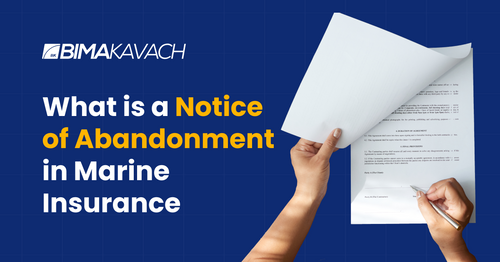Marine insurance is a type of insurance that covers ships, cargo, and other maritime interests against loss or damage. It provides protection against risks such as piracy, fire, collision, and natural disasters. It is important for businesses that rely on shipping to transport goods. It provides a way to manage the risks associated with shipping, which can be unpredictable and costly. Within the intricate domain of marine insurance, there exists a term of paramount importance – the "Notice of Abandonment."
It is a concept that holds the power to alter the course of a maritime insurance claim, significantly impacting the lives and livelihoods of shipowners, cargo owners, and insurers alike. In this article, we will dive deep into the depths of the maritime world to unravel the mystery surrounding the Notice of Abandonment. We will explore what it means, when and why it is used, and the ramifications it carries for all parties involved.
Understanding Notice of Abandonment
Notice of abandonment is an important concept in marine insurance that is used to protect the interests of both the insurer and the insured. It is a legal notice that the insured provides to the insurer, indicating that they are abandoning their interest in a particular insured property, in exchange for a payment of the vessel's insured value. This notice is usually given when the property has been lost or damaged beyond repair, and the insured wishes to claim compensation under their marine insurance policy.
Once the notice of abandonment is made, the insurer has the option to either accept or reject the abandonment. If the insurer accepts the abandonment, it becomes the owner of the vessel or cargo and is responsible for its disposal. The insurer is also required to pay the insured the value of the vessel or cargo as stated in the insurance policy. However, if the insurer rejects the abandonment, the insured remains the owner of the vessel or cargo and is entitled to pursue other avenues of recovery, such as filing a claim for partial loss or invoking the sue and labor clause.
Get Free Quote in Minutes
The notice of abandonment is an essential tool for the insured to ensure that they receive the full value of their policy in the event of a loss. It allows the insurer to assess the extent of the loss and determine the appropriate compensation to be paid. It is important to note that the notice of abandonment must be made within a reasonable time after the loss occurs and must be supported by evidence of an actual or constructive total loss. The evidence must be sufficient to convince a reasonable person that the loss is beyond economic repair or recovery.
Process of Filing a Notice of Abandonment
Initial Steps
When a vessel is damaged or lost, the owner or captain may decide to file a Notice of Abandonment with their marine insurance company. This notice is a formal declaration that the owner is relinquishing all rights and interests in the vessel to the insurer. However, the process of filing a Notice of Abandonment is not as simple as just sending a letter to the insurance company.
The first step in filing a Notice of Abandonment is to determine whether the damage or loss is covered by the insurance policy. The owner or captain should review the policy carefully to see if it includes provisions for abandonment, and what conditions must be met for the abandonment to be valid. If the policy does not cover abandonment, or if the conditions for abandonment are not met, the owner may not be able to file a valid Notice of Abandonment.
Once the owner has determined that the damage or loss is covered by the policy, they should contact the insurance company as soon as possible to report the incident and begin the claims process. The insurance company will likely send a claims adjuster to investigate the damage or loss and determine the extent of coverage.
Insurance Company's Role
If the insurance company agrees that the damage or loss is covered by the policy and that the conditions for abandonment have been met, the owner can file a Notice of Abandonment. The notice should include a description of the vessel, the circumstances of the loss or damage, and a statement that the owner is abandoning all rights and interests in the vessel to the insurer.
The insurance company will then evaluate the notice and determine whether to accept or reject the abandonment. If the abandonment is accepted, the insurer will take possession of the vessel and may sell it to recover the amount of the claim. If the abandonment is rejected, the owner may still be able to file a claim for the damage or loss under other provisions of the policy.
Filing a Notice of Abandonment in marine insurance requires careful consideration of the insurance policy and the circumstances of the loss or damage. The owner or captain should work closely with the insurance company to ensure that all necessary steps are taken to file a valid notice and protect their interests.

Legal Implications of Notice of Abandonment
When a marine vessel is damaged or lost, the owner may choose to abandon the vessel and make a claim under their marine insurance policy. The notice of abandonment is a crucial step in this process, as it formally notifies the insurer that the owner is relinquishing their rights to the vessel and any potential salvage value.
Once the insurer receives the notice of abandonment, they have a limited amount of time to either accept or reject the claim. If the claim is accepted, the insurer becomes the owner of the vessel and is responsible for any salvage or disposal costs. If the claim is rejected, the owner may be able to pursue other options such as salvage or repair.
It is important to note that the notice of abandonment must be made promptly and as per the terms of the insurance policy. Failure to do so may result in the claim being denied or reduced. In addition, the notice of abandonment may have legal implications beyond the insurance claim. For example, if the vessel is abandoned in a navigable waterway, the owner may be subject to fines or other penalties for violating environmental regulations.
Real-life Scenarios and Case Studies
Here are a few real-life scenarios and case studies that illustrate the importance of notice of abandonment in marine insurance:
Scenario 1: Vessel Grounding
A cargo vessel ran aground on a reef, causing significant damage to the hull and cargo. The vessel owner immediately notified their insurer of the incident and filed a claim for the damages. The insurer conducted an investigation and determined that the vessel was a total loss. The owner then submitted a notice of abandonment, which allowed the insurer to take possession of the vessel and cargo and settle the claim.
Scenario 2: Fire on Board
A container ship caught fire in the middle of the ocean, causing extensive damage to the vessel and cargo. The crew was able to contain the fire and prevent it from spreading, but the damage was still significant. The vessel owner filed a claim with their insurer and submitted a notice of abandonment, which allowed the insurer to take possession of the vessel and cargo and settle the claim.
Case Study: MV Rena
The MV Rena was a container ship that ran aground on a reef off the coast of New Zealand in 2011. The incident caused a major oil spill and significant damage to the vessel and cargo. The owners of the vessel filed a claim with their insurer and submitted a notice of abandonment. The insurer conducted an investigation and determined that the vessel was a total loss. The insurer then took possession of the vessel and cargo and settled the claim with the owners.
Conclusion
As we have navigated through the intricacies of the concept of a "Notice of Abandonment", we have uncovered its significance in addressing the unpredictability and risks inherent in marine endeavors. By comprehending when and why this notice is invoked, we have shed light on the complexities of insurance claims for vessels and cargo, ultimately promoting a more informed and secure maritime world. In essence, the Notice of Abandonment serves as a testament to the insurance industry's adaptability and resilience in the face of maritime challenges. It underscores the commitment to protecting the interests of all parties involved, ensuring that the prevailing uncertainties do not erode the foundations of trust that underpin the marine insurance sector.
Frequently Asked Questions (FAQs)
1. Can a Notice of Abandonment be revoked once it's submitted?
Generally, once submitted, a Notice of Abandonment is irrevocable, as it initiates the claims process.
2. Can the insurer dispute a Notice of Abandonment?
Yes, the insurer can dispute the validity of the Notice of Abandonment if it believes that the conditions for abandonment have not been met.
3. How does the Notice of Abandonment impact the marine insurance industry as a whole?
The Notice of Abandonment is a cornerstone of the marine insurance industry, providing clarity and structure to the claims process, ultimately benefiting both insured parties and insurers by ensuring a fair and efficient resolution of total loss situations.

